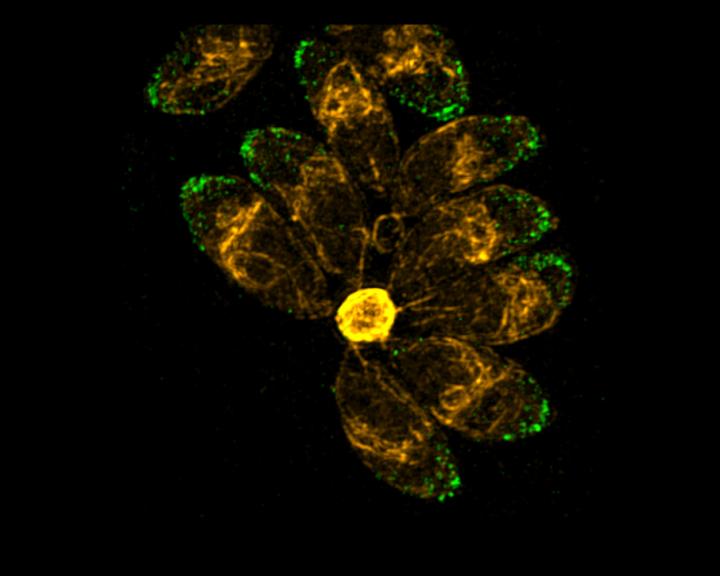Toxoplasma gondii
, the unicellular causative agent of toxoplasmosis, reproduces itself in an unusual fashion by means of an internal budding process. This entails the development of two daughter cells within the cytoplasm of the mother cell. On completion of this process, the mother cell undergoes lysis, and the daughter cells are released into the infected host cell. The daughter cells continue to proliferate until the host-cell itself finally bursts.
T. gondii
is a globally distributed infectious agent. As a rule, the infection is innocuous. However, during pregnancy, transmission of the parasite to the fetus can severely damage the development of the latter. A group of researchers led by Markus Meissner, Professor of Experimental Parasitology at LMU in collaboration with Dr. Javier Periz at Glasgow University, has now described a phenomenon which plays an important role in asexual reproduction – during internal budding, components of a specific organelle are donated by the mother cell to the daughters. The study appears in the online journal
Nature Communications
.
In order to recognize, adhere to and infect host cells,
T. gondii
makes use of organelles called rhoptries and micronemes, which secrete a set of specialized proteins that enable the parasite to invade the target cell. Once the infection has been successfully established, the parasite divides. It had been assumed up to now that the micronemes in the daughter cells are reformed from scratch. However, by specifically labelling one of the micronemal proteins, the authors of the new study were able to follow the fate of the microneme during the cell cycle with the aid of high-resolution microscopy. The observations revealed that the components of the mother cell’s microneme are divided more or less equally between the daughter cells. In addition, micronemal proteins are newly synthesized in the daughter cell. The researchers assume that this recycling is not limited to the micronemes, but serves as a more general mechanism to enable the reassembly of organelles that are vital for propagation of the parasite.
“Furthermore, we have shown that recycled micronemes are transported from mother to daughter by the actin filaments of the cytoskeleton,” says Markus Meissner. “This is an entirely new function for actin in the parasite. Up to now, actin was thought to be involved solely in cell motility in
T. gondii
. When we have a better understanding of how this newly discovered function of actin is regulated, we may also be able to identify novel drug targets. This is a very interesting prospect because
T. gondii
is known to possess very few actin-regulating proteins.”
###
Nature Communications
2019
This part of information is sourced from https://www.eurekalert.org/pub_releases/2019-09/lm-pmc091319.php
Dr. Kathrin Bilgeri
0049-892-180-3423
[email protected]
http://www.uni-muenchen.de


